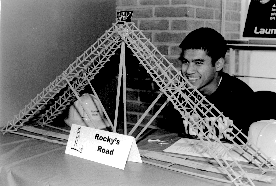|
|
Engineers Use Their NoodlesEngineering: Students discover the recipe for building bridges
Aaron Levin |

 Freshmen in the Whiting School of
Engineering may
graduate in the 21st century, but they are already building
bridges--with materials picked up at the local Giant.
Freshmen in the Whiting School of
Engineering may
graduate in the 21st century, but they are already building
bridges--with materials picked up at the local Giant.
Each year, Professor Michael Karweit requires students in his freshman engineering course to build a 1-meter-long, 750-gram bridge using nothing but spaghetti and glue. Not just a tribute to great Italian thinkers (Da Vinci? Galileo? Fellini?), the spaghetti bridge is Karweit's way of pushing students to combine engineering theory and practice.
The finished projects are entered into an open competition, held this year on Nov. 9 at the Maryland Science Center. Explains Karweit, "Maris St. Cyr at the center knew that I do this project and thought it would be a wonderful way to make fun science available to the outside community."
The class, aimed at people undecided about a career in engineering, is a way to learn how engineers think and solve problems, says Karweit.
Students begin by measuring the strength of spaghetti in the lab. Next, they calculate the tensions and compressions of a bridge on the computer, and then comes the hard part.
"Few students today have ever spent time in a lab or workshop," says Karweit. "They're good on ideas and theory, but practicality is a new experience."
The winners, he says, not only have good designs but must build them carefully.
"Are things lined up straight?" he asks. "Is the epoxy mixed right? If not, the glue won't cure, and the joint may not hold. Then you get the 'zipper effect': When one thing goes, then everything else fails, too."
Of course, Karweit has serious purposes in mind when he assigns the bridge project. Steel or spaghetti, the principles are the same.
"I'm trying to get students to integrate engineering theories in one project, to get them to calculate and design ahead of time, and to predict what will happen with their designs," says Karweit. "They also have to learn to work in teams. Employers today are looking for engineers with people skills not just technique."
Everyone in the class uses spaghetti out of the box, although tests have shown that cooked and redried pasta is actually stronger. "The problem," says Karweit, "is getting it to dry straight again after it's been cooked."
This year the team of Robert Matarese, Mark McCoy and Luke Petre, whose span carried 46 kilograms (101 pounds), split the $100 first prize. Karweit also builds a bridge each year, although he disqualifies himself from the contest. A good thing for the students, too: his bridge held 106 kilograms (233 pounds).
The young engineers have even more to shoot for, though. The record load for a spaghetti bridge built to these specifications is 176 kg--over 387 pounds--enough to support Baltimore Ravens defensive end Tony Siragusa and 67 pounds of spaghetti alla Bolognese.